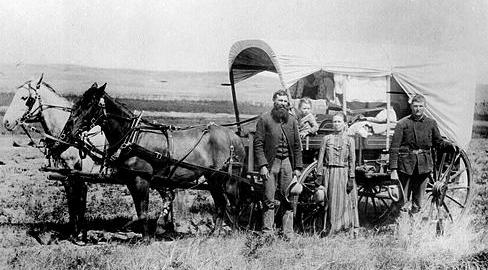On May 20, 1862, Abraham Lincoln signed the Homestead Act, an effort by the U.S. government to make 160 acres available to anyone who would move to unclaimed territory, build a cabin, farm the land, and live there for five years. Eventually 270 million acres were privatized by the process, ushering in the great era of “free land.” Now, 150 years later, we have the opportunity to look at homesteading as it actually worked.
Throughout the nineteenth century the federal government was committed to disposing of the vast acreage that it owned. The privatization process was important for the growth of the market economy. But the homesteading process was a wasteful way of creating private rights, and the land sales that preceded homesteading were a much less wasteful method.
There were several problems with the original Homestead Act and its subsequent alterations. The original provision of 160 acres was insufficient for agriculture in the arid west, and even when it was expanded to 320 acres in 1909 and 640 acres in 1916 it still did not provide enough acreage to support a family in most of the places where people settled. In fact, only 40 percent of those who started the homestead process were able stick it out and finalize their claims.
An even more important lesson is that it is very difficult for the government to give away almost anything for free. In the case of homesteading, much of the land available was beyond the “profitable frontier,” the point at which the lack of a market for agricultural products made settlement unprofitable. But settlers knew the land was going to be valuable at some point in the future so they raced into the West, making their claims as early as they possibly could in order to have secure property rights when the returns from the land turned positive.
People bid for the land not with money but with wasted resources, the time and effort they put into “proving up” their claims in anticipation of future profits. Many families suffered years of deprivation trying to eke out a living until they could make their claim profitable or, once they had established property rights, buying out someone else in order to obtain an operation large enough to survive.
Think of what would happen if your institution announced that it was running a budget surplus and that on June 1st $1000 would be given to the first 20 people who lined up outside the CFO’s office. People would calculate how much time they could spend standing in line in order to get $1000 and, in the limit, $20,000 would leave your organization’s coffers. But almost no benefit would be bestowed on the recipients. People would be quite willing to spend $900 of their time in order to get $1000. Some would spend $999.
The other problem with the homesteading process was that it was so costly and difficult to use that much of the western United States remained as public lands. Today, more than half of the land in the West is under federal ownership. These lands have been subject to environmental and financial mismanagement, as documented by PERC’s Holly Fretwell.
Thus the Homestead Acts had two unfortunate results: 1) the process was an unduly costly way to dispose of federal lands and 2) because of the unworkability of homesteading much of the land was never privatized.




